University rankings and international student enrollment are mutually reinforcing. Top universities draw talented students from around the globe, and in turn, these students enhance the academic and cultural profile that boosts rankings. As competition intensifies, attracting and supporting international students is becoming a cornerstone strategy for institutions striving to enhance their global reputation and expand reach.
To stand out in a crowded, complex landscape, institutions must offer unique value and clearly demonstrate return on investment (ROI) to prospective students.
In this blog, we’ll explore the key trends, benefits, and challenges shaping international student recruitment in 2025. By understanding these dynamics, higher-ed institutions can position themselves to attract top global talent, cultivate a diverse student body, and tackle the challenges of the enrollment cliff.
Summary of key findings
- Setting a new record: The total number of international students in the US reached an all-time high of over 1.1 million for the 2023-2024 school year.
- Post-pandemic increase: Since 2020, the number of international students has increased each year with a 7% increase in 2023-2024.
- An uncertain future: In 2024-2025, there was a 5% decrease in new international student enrollment, and geopolitical factors may affect future enrollment and recruitment efforts.
- Countries of origin: Over 70% of international students in the US come from India and China.
- Value of international students: Recruiting more international students can have a positive impact on an institution’s campus culture, innovation, and financial growth.
- Economic impact: During the 2023–2024 academic year, international students contributed $43.8 billion and over 378,000 jobs to the US economy.
- Appealing to prospects: International prospects are looking for value and clear career pathways from their college degree program.
- Recruitment strategies: To reach international prospects, admissions offices must prioritize digital marketing tactics, and leverage engagement platforms to effectively reach and nurture potential applicants.
Trends in international student recruitment in the US
The total number of international students in the US reached an all-time high of over 1.1 million for the 2023-2024 school year, reflecting a 7% increase from the previous year. This surge not only highlights a strong post-pandemic recovery—particularly in graduate programs—but also underscores the significant economic impact of international students, who contributed $50 billion to the US economy in 2023, according to Forbes.
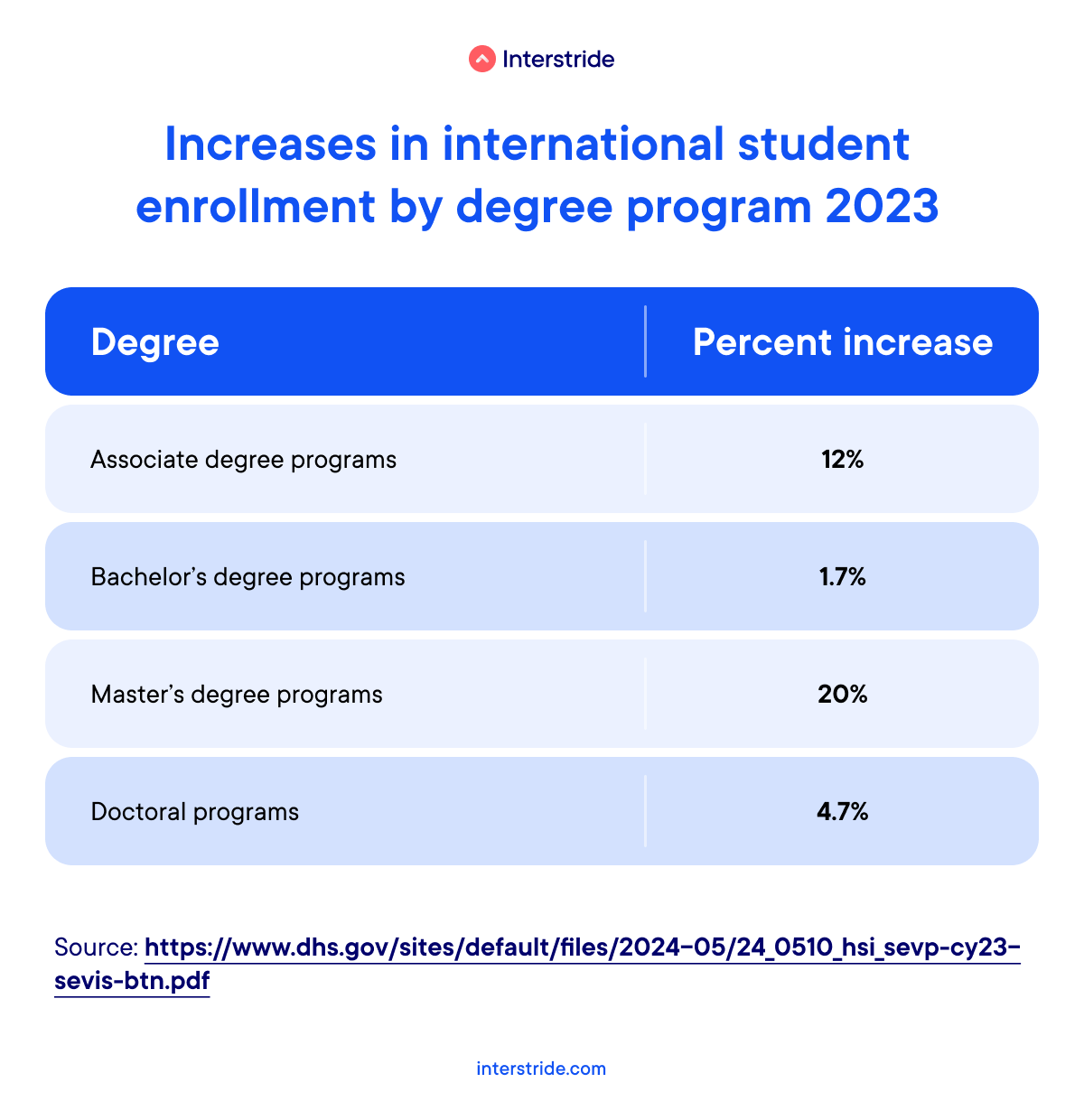
Students from over 235 countries now study in the US, with India (377,620 students) and China (330,365 students) leading the way. Combined, these two countries account for over 70% of the total international student population. However, other countries, such as South Korea, Canada, and Brazil, are showing steady growth in their contributions to the US international student landscape, reflecting the increasing diversity of origin countries.
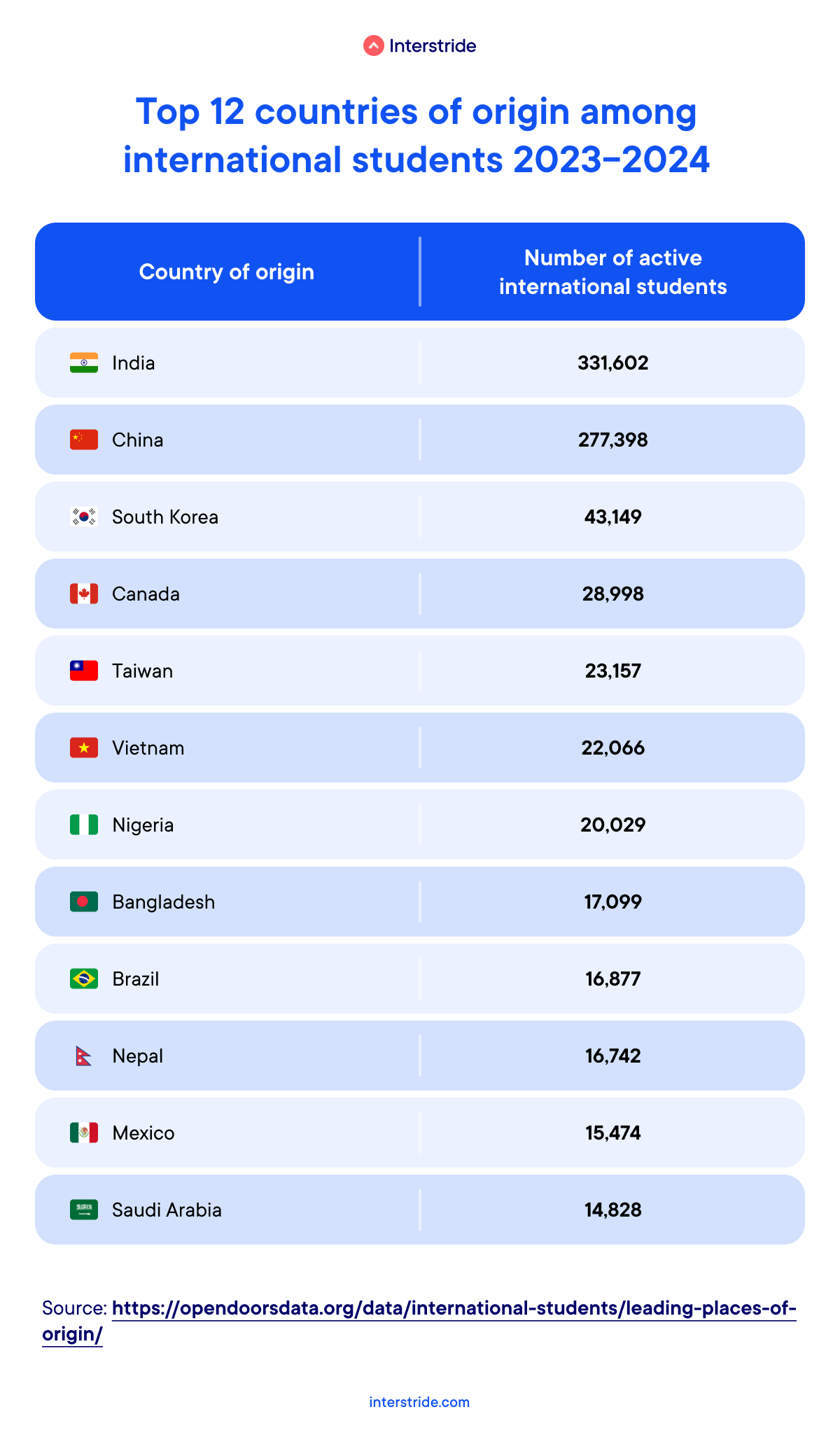
Regionally, international student enrollment grew across all US census regions between 2022 and 2023. The South saw the largest growth at +13.4%, followed closely by the Midwest with +13.2%, and the Northeast at +10.5%. The West also experienced growth, though at a more modest +5.7%. These increases indicate that institutions across the country are seeing growing interest from international students, though the scale of growth varies by region.
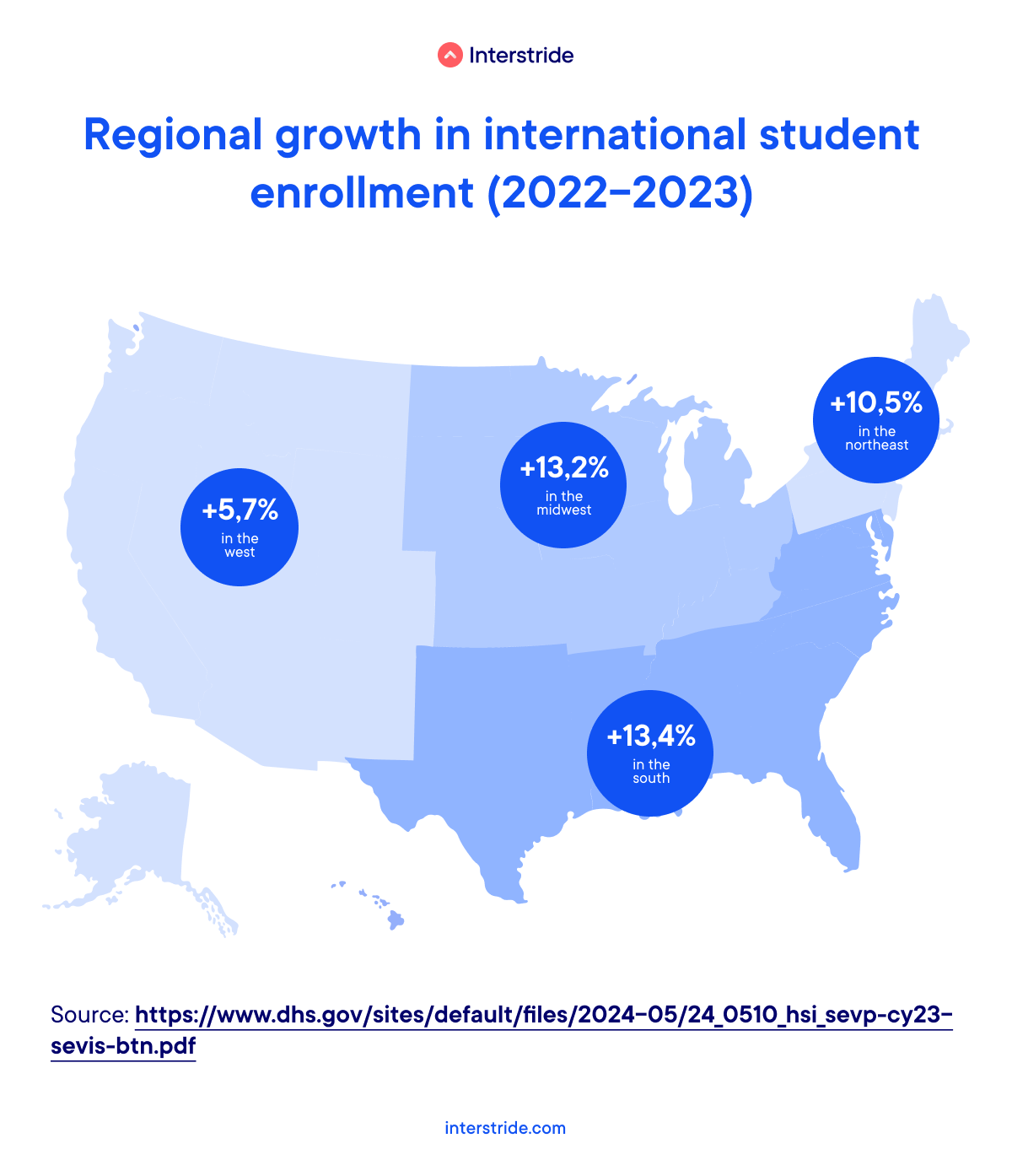
Despite these gains the 2024-2025 academic year saw a 5% decline in new international student enrollment, suggesting a need for strategic efforts to maintain momentum. US institutions face fierce competition from top universities in other leading study destinations, including the UK, France, Australia, and Canada. To remain competitive, US universities must not only differentiate themselves globally but also navigate restrictive immigration policies that create barriers for prospective students.
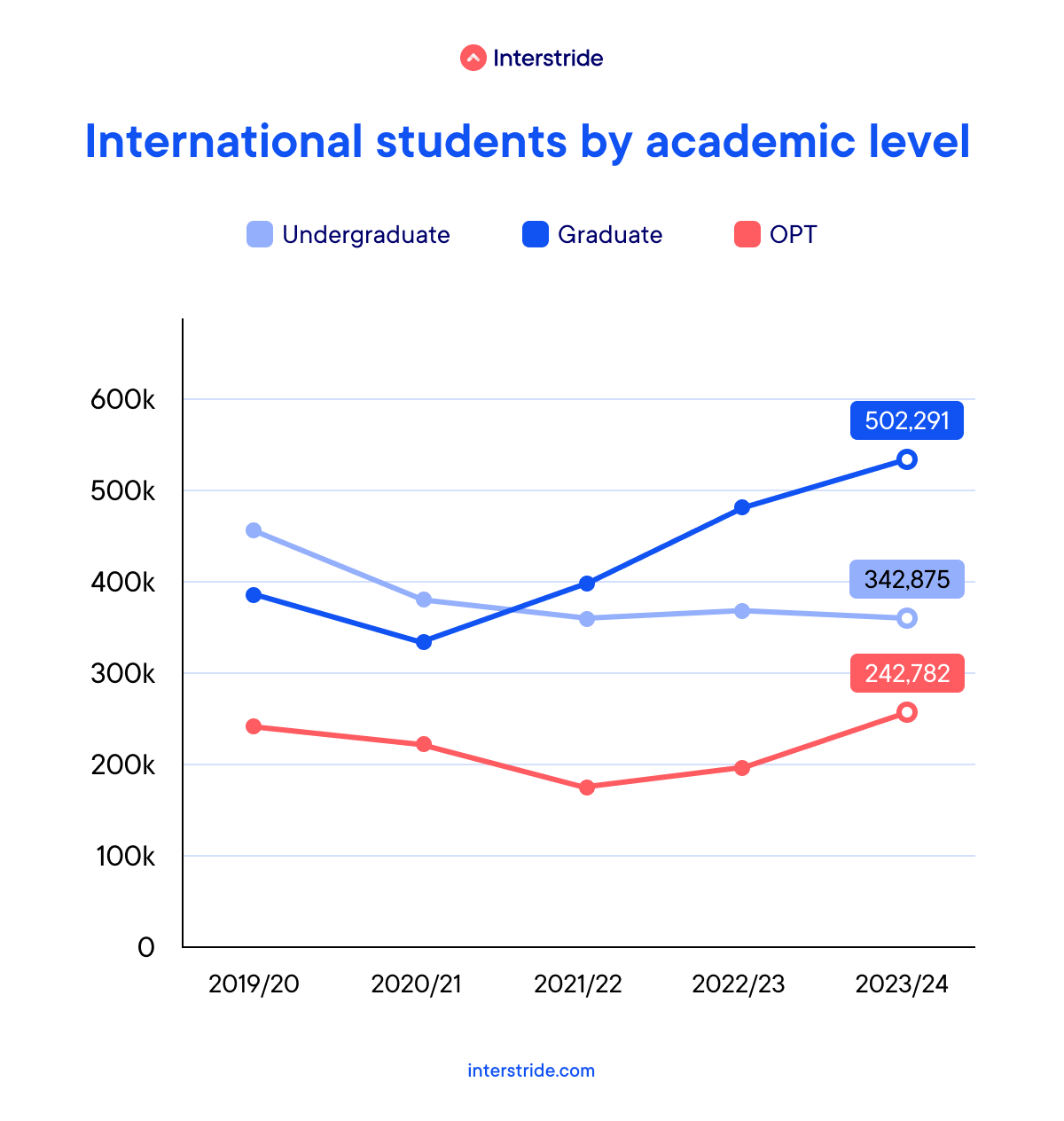
How international recruitment fuels university growth and global impact
International student recruitment plays a vital role in higher education, driving institutional growth, global reputation, and innovation. By attracting students from around the world, universities create diverse campuses, secure essential funding, and foster cultural exchange. This strategy not only supports the sustainability of institutions but also positions them as leaders in global education.
Here are four key reasons why international student recruitment is vital:
- Fosters cultural diversity on campus – International students bring unique perspectives that enrich campus life, fostering cultural exchange and mutual understanding. This diversity benefits both domestic and international students, shaping culturally aware graduates who thrive in global and inclusive environments.
- Drives financial growth – International students contribute significantly to university funding by paying out-of-state tuition fees, often two to three times higher than in-state rates. In 2023, international students added $50 billion to the US economy, with a substantial portion going directly to universities, supporting academic programs, research, and campus resources.
- Boosts institutional reputation – A diverse international student body strengthens a university’s global presence and reputation. Positive experiences shared by international students enhance an institution’s image abroad, attract more prospective students and faculty, and contribute to higher rankings—ultimately securing additional funding and partnerships.
- Drives innovation and economic impact – International students fuel innovation by introducing diverse viewpoints and experiences. They help shape future global leaders and professionals, contributing to both the US and global economies. There are nearly 180 billion-dollar US companies that were founded or co-founded by a former international student. Former international students also make up nearly 25% of billion-dollar startup companies in the US, creating on average, 800 jobs per startup.
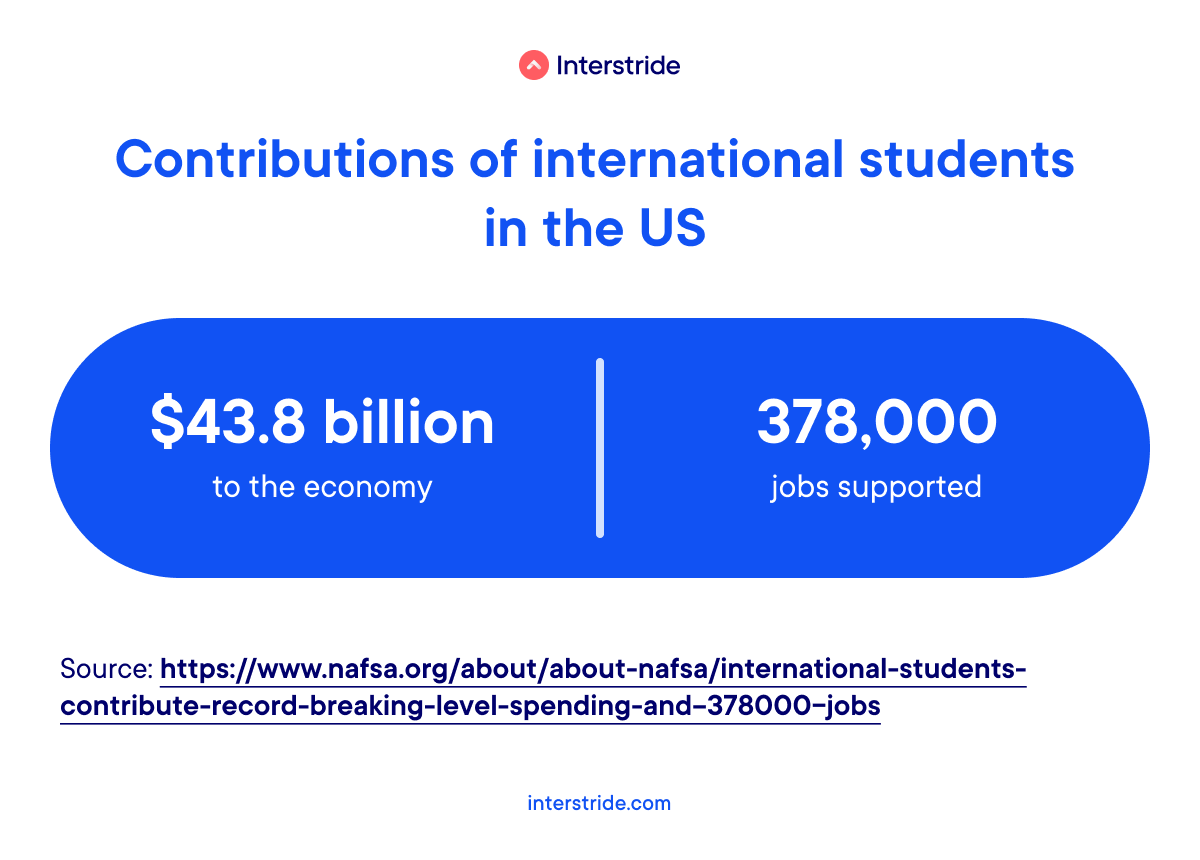
By prioritizing international student recruitment, higher education institutions create thriving, diverse campuses while contributing to cultural exchange, economic growth, and global innovation.
Top 9 challenges of international student recruitment in 2025
Recruiting international students presents a unique set of challenges. From navigating restrictive immigration policies to addressing rising costs and growing competition, universities face significant hurdles in attracting and enrolling top global talent.
Below, we outline the top challenges shaping international student recruitment in 2025 and strategies institutions can adopt to overcome them.
1. Fierce competition in the global education market
A key challenge in international student recruitment is the increasing competition in the global education market. Countries like China, Germany, Japan, and South Korea are ramping up their marketing efforts, streamlining visa processes, and offering attractive post-graduation work opportunities to draw international students.
Meanwhile, Canada and the UK, historically top-choice destinations, have reached 22-30% international student enrollment capacity, leading to discussions on limiting further growth. In contrast, international students comprised just 6% of total US higher education enrollment in 2023, highlighting the untapped potential for U.S. institutions to attract more global talent.
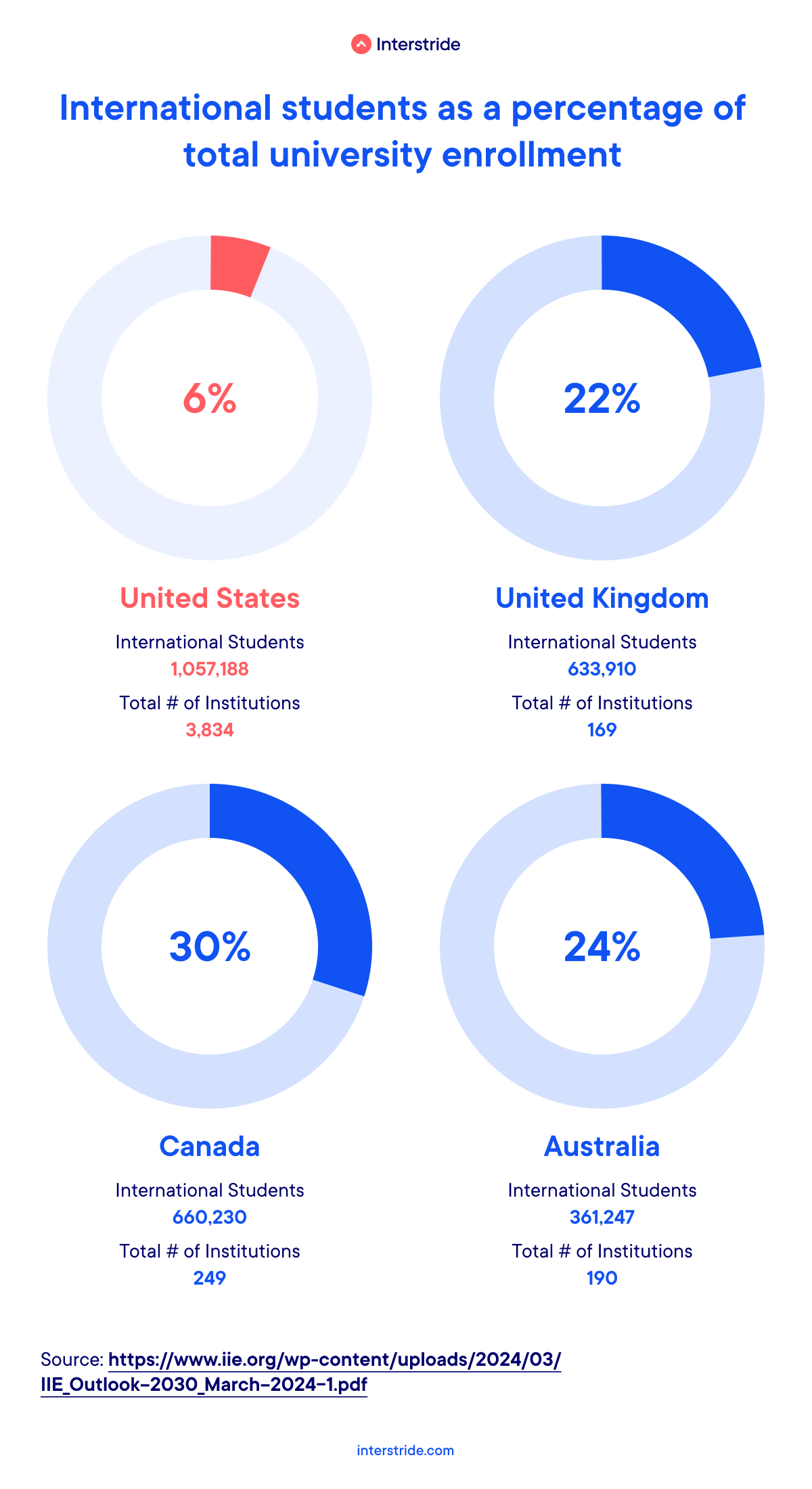
With Canada and the UK tightening study permit regulations, US universities have a unique opportunity to fill this gap. To remain competitive, institutions must modernize recruitment strategies, highlight their unique strengths, and build robust digital presences to effectively engage and convert prospective international students.
2. Lack of employability and immigration pathways
International students often seek career opportunities in their host country after graduation. However, the lack of clear pathways for work and immigration in the US after graduation deters many prospective students. The reality is that most international graduates are not able to remain in the US.
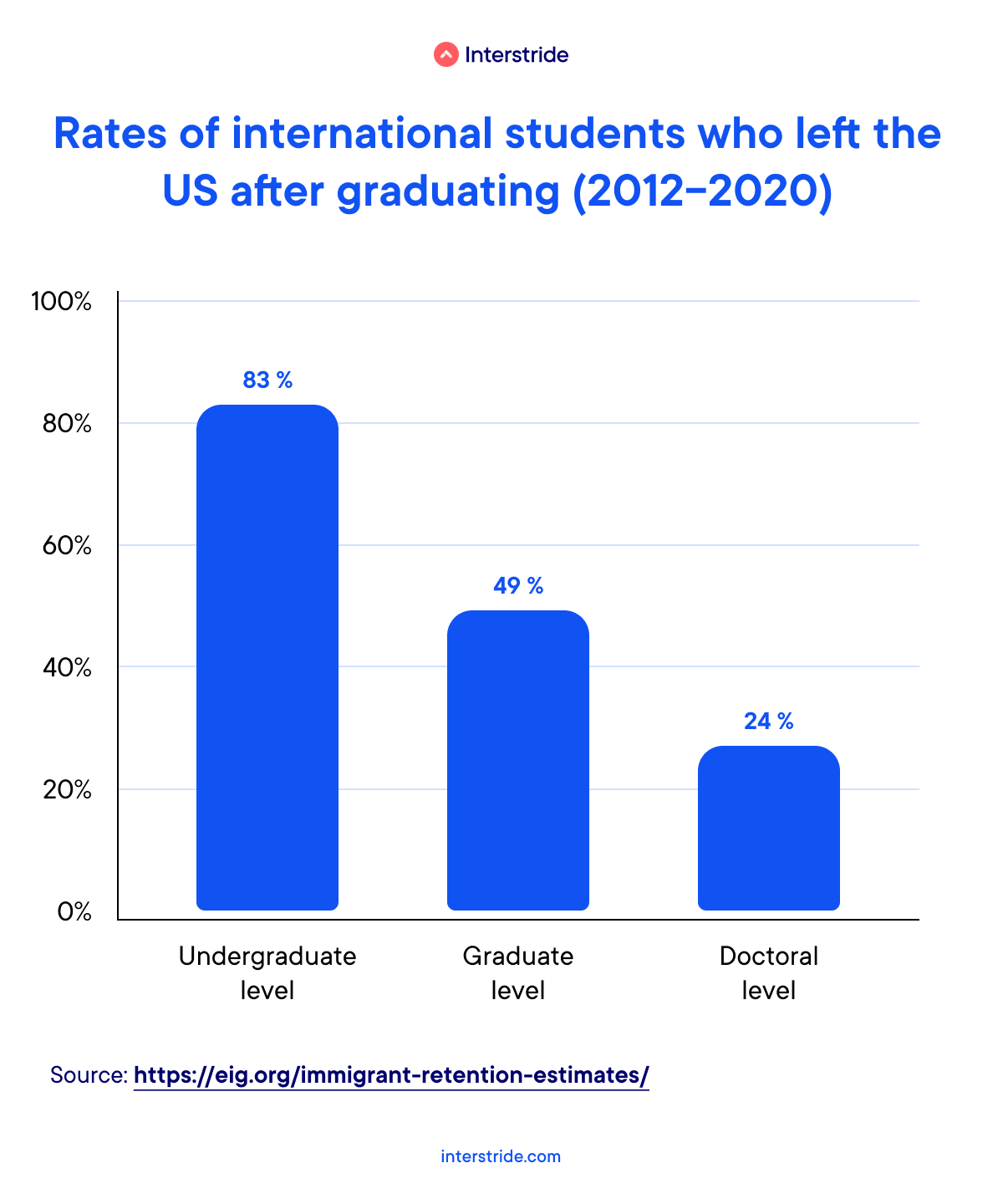
Universities must address these concerns by highlighting career support services and providing transparent information on work options, such as OPT and CPT, and career outcomes. Admissions and career centers can work together to drive recruitment and enrollment.
Interstride tip!
Here are ways to demonstrate the return on investment of a degree from your institution:
- Share employment data:
- How many international students secure employment through OPT or CPT?
- What percentage of international students get full-time job offers after graduation?
- What is the annual average salary for international alumni in various fields?
- Who are the top employers for international alumni in various fields?
- Highlight graduation rates
- Spotlight student success stories
3. Nationalism, politics, and anti-immigration rhetoric
The rise of nationalist and anti-immigration sentiments is a key challenge to international student recruitment in the US. Concerns about potential policy changes under the new administration have left many international students uncertain about their future in the country.
These uncertainties have led some prospective international students to explore alternative destinations where they feel more welcomed and supported. Chinese international students, who accounted for about 25% of the US international student population in 2023-2024, have been particularly impacted. Ongoing U.S.-China tensions have intensified concerns about safety and acceptance and the number of Chinese college students in the US has not returned to pre-pandemic levels.

To combat these challenges, universities must actively foster welcoming and inclusive environments, demonstrating their commitment to diversity through actionable initiatives. According to NAFSA, schools that prioritize these efforts have seen a more stable enrollment among international students, even as the broader national climate has become less welcoming.
4. The global economy and rising costs of higher education
Rising tuition fees and increasing living costs present significant financial barriers for many international students. Economic instability further exacerbates these challenges, leaving families hesitant to invest in overseas education without confidence in the return on their investment.
According to the College Board, average tuition and fees for out-of-state students at public four-year institutions in the U.S. have increased by 37% over the last decade, with total annual costs—including living expenses—often exceeding $50,000. International students frequently face even higher expenses when factoring in travel costs and limited work opportunities.
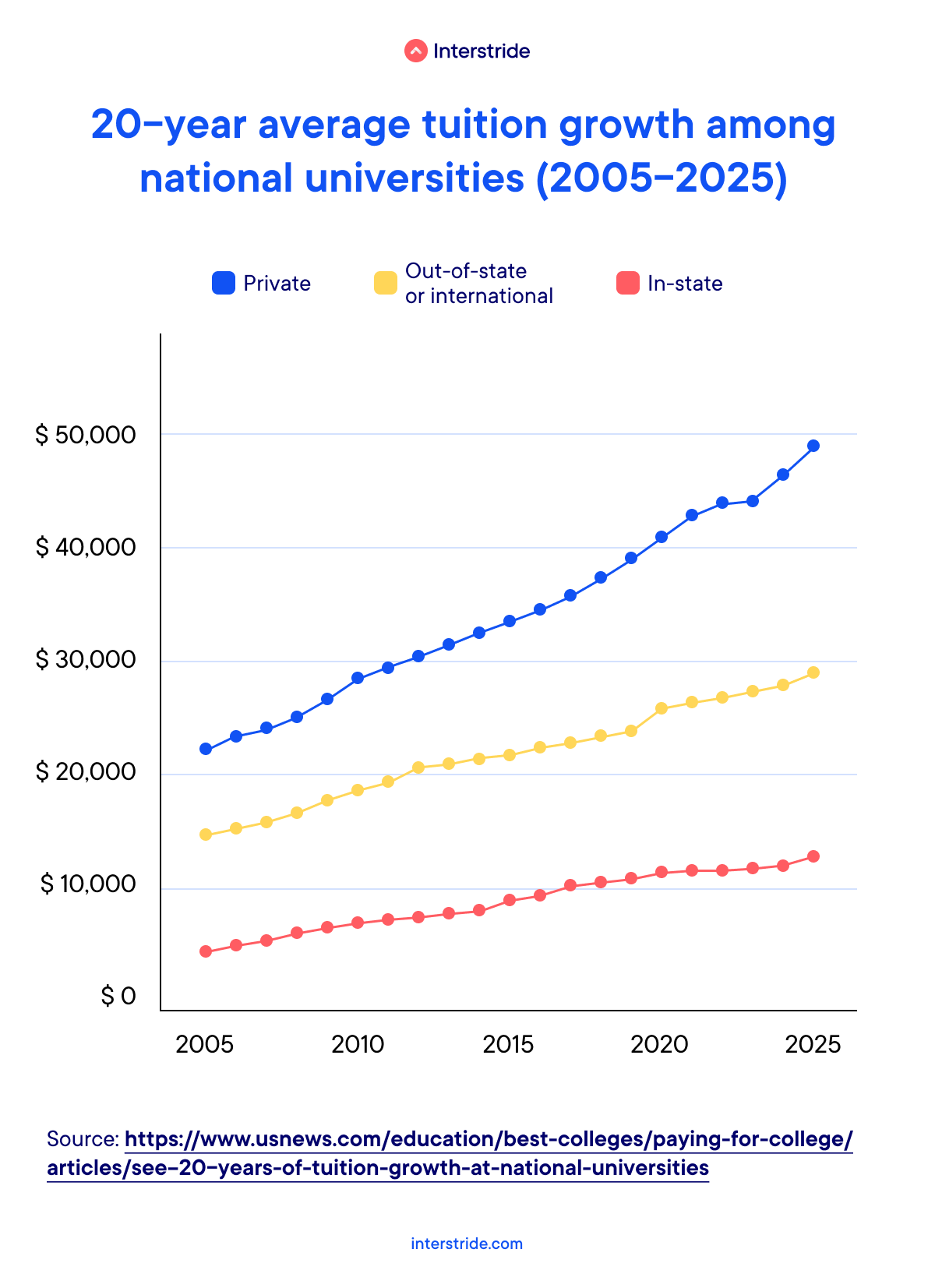
Many international students rely on family funding, and growing financial strain reduces the number of eligible candidates. Ben Waxman, CEO of Intead, predicts that the purchasing power of international students will decline in the coming decades, pushing prospective students to explore more affordable options in countries like Canada, Australia, or the UK, where tuition fees are typically lower.
Interstride tip! Proactively address international students’ financial concerns:
5. Securing budget for international student recruitment
Effectively recruiting international students requires a dedicated budget for marketing and outreach, but securing these resources remains a significant challenge. Institutions that focus primarily on domestic recruitment often overlook the strategic benefits of enrolling more international students, including enhanced financial health and an elevated global reputation.
Allocating funds for international student recruitment has been particularly difficult in recent years. Fluctuating economic conditions and bureaucratic hurdles complicate the approval process, with budgets for international recruitment decreasing by an average of 2% between 2020 and 2022 at both public and private institutions.
To justify and secure a sustainable budget for international recruitment, institutions should emphasize the cost-effectiveness of these efforts. In many cases, the cost of recruiting an international student is lower than recruiting a domestic student, yet international students typically contribute more through higher tuition fees. Highlighting this ROI can help demonstrate the value of investing in international recruitment initiatives.
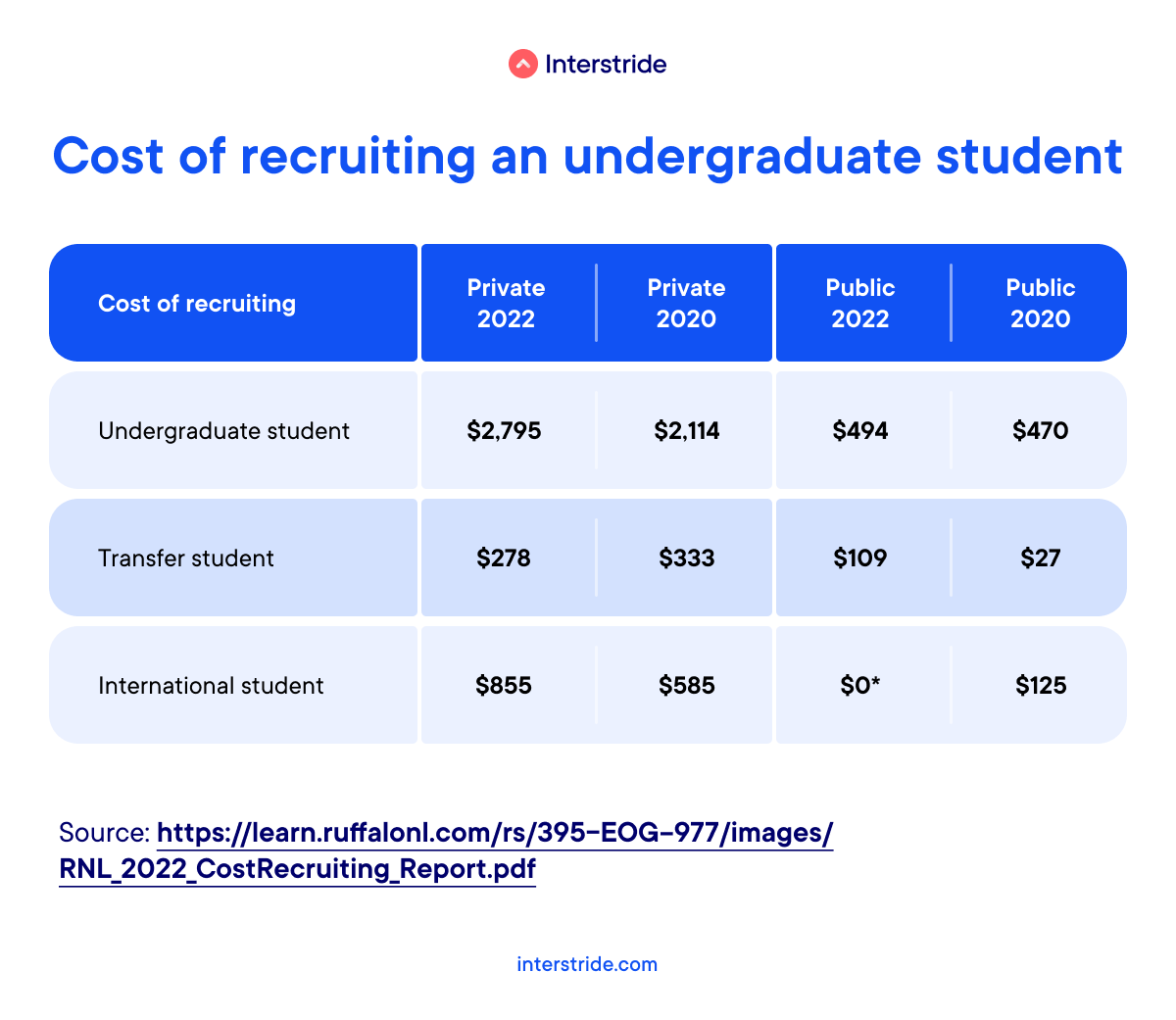
By making a compelling case for the financial and reputational benefits of international students, institutions can advocate for the resources needed to attract and retain a diverse global student body.
6. Generating enough quality leads and applications from prospective students
Attracting enough high-quality leads and applications from prospective international students is a significant challenge for universities. This challenge is especially pressing for U.S. universities, which are increasingly relying on international enrollments to mitigate the effects of the looming enrollment cliff.
International students often have specific needs and expectations that require tailored recruitment strategies. To capture their interest, institutions must move beyond traditional approaches. Leveraging targeted digital marketing and personalized engagement strategies is essential to effectively connect with and support students throughout the admissions journey. Tools like AI for content creation and SEVIS-compliant platforms for visa tracking can streamline communication and make the process more efficient.
Building early and consistent engagement with prospective students is equally critical. By establishing relationships early, universities can qualify applicants to ensure they are a good fit, financially prepared, and likely to complete their program. This proactive approach not only increases enrollment but also enhances retention and student satisfaction.
7. Identifying the right tools for international student recruitment
Choosing the right tools for international student recruitment is essential but often overwhelming given the vast number of options available. To succeed, institutions need tools that enable them to seamlessly connect with prospective students, nurture interest, and streamline the admissions journey.
Engagement platforms like Interstride stand out as comprehensive solutions, empowering universities to offer personalized support and valuable resources to international applicants. The Interstride Admissions Portal provides prospective students with opportunities to connect directly with admissions teams and student ambassadors, fostering meaningful engagement and trust. It also offers built-in tools and resources to support prospects in their admissions, immigration, and career journey.
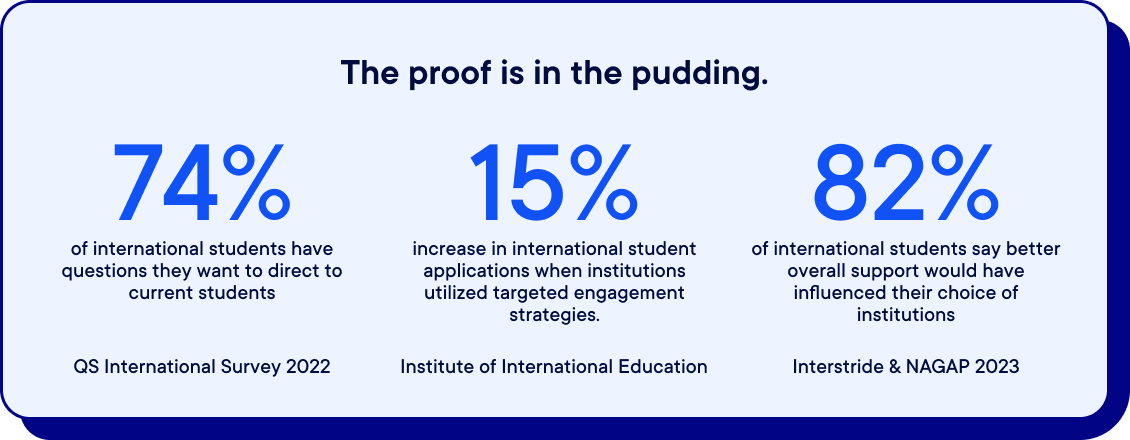
By investing in technology that enhances efficiency and focuses on the unique needs of international students, universities can position themselves as leaders in global recruitment, build stronger connections with students, and deliver a world-class admissions experience.
Interstride tip!
International students value closer engagement with admissions offices, and utilizing the right tools and services during the prospecting phase can significantly improve conversion rates while diversifying the applicant pool. Download our 2022 report to discover how enhancing the admissions experience can help boost international student enrollment.
8. Impact of geopolitical factors
Geopolitical tensions, wars, and conflicts significantly affect international student recruitment efforts in the US. Students from unstable regions often face barriers such as disrupted educational systems, financial insecurity, and safety concerns, leading to a noticeable decline in outbound mobility. For prospective students, these challenges are further complicated by difficulties in securing visas, arranging travel, and navigating new cultural environments.
To support students from conflict-affected regions, universities should offer tailored resources and accommodations. These could include targeted scholarships, mental health counseling, and flexible admissions processes to help students overcome barriers and continue their education.
In addition, partnering with organizations that assist refugees and displaced individuals can create meaningful pathways for these students. By prioritizing diversity and inclusivity, institutions not only enhance their global impact but also provide all students with the opportunity to engage with diverse perspectives and global issues, enriching the campus experience.
International student recruitment is challenging—but it doesn’t have to be
Engaging prospective students early and consistently throughout the admissions journey is key to successful recruitment. This involves addressing their concerns—such as finances, immigration, career prospects, and community—while providing the right resources and meaningful connections to build trust and confidence.
With tools designed to enhance every step of the admissions journey, the Interstride Admissions Portal empowers universities to stand out, drive applications, and ensure long-term success.
Learn more about how the Interstride Admissions Portal can help you transform international student recruitment.

